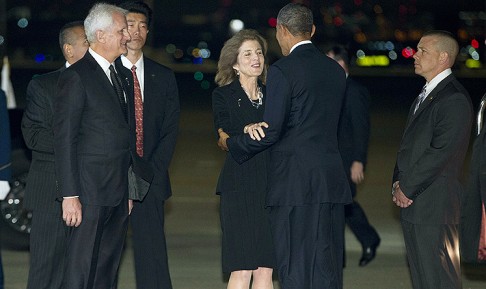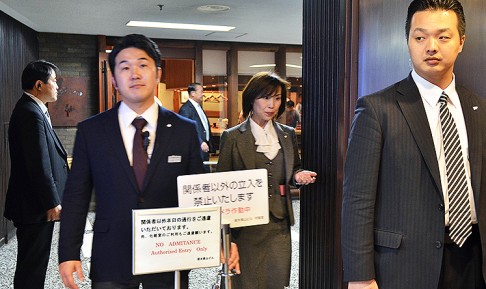
Obama touches down in Japan for first leg of tension-filled Asian tour

US President Barack Obama landed in Tokyo on Wednesday to launch an Asian tour dedicated to reinvigorating his policy of “rebalancing” US foreign policy towards a dynamic Asia.
Obama landed aboard Air Force One to begin a state visit to Japan, which comes as regional tensions boil over maritime territorial disputes and fears that North Korea could soon carry out a new nuclear test.
The president touched down a day after nearly 150 lawmakers paid homage at a controversial Tokyo war shrine seen by neighbouring nations as a symbol of Japan’s brutal imperialist past, and shortly after the prime minister made a shrine offering.
Days earlier, China seized a huge Japanese freighter over what a Shanghai court says are unpaid bills relating to Japan’s 1930s occupation of vast swathes of the country.
In the seas to the southwest, boats from China and Japan spar for ownership of a small chain of islands. And an ever-unpredictable North Korea – which has denounced the presidential tour as “reactionary and dangerous” – appears to be trying to seize the spotlight with preparations for a fourth nuclear test.
Despite the increasingly tense security situation, getting top regional US allies Japan and South Korea – Obama’s next destination – to talk to each other is tricky.
South Korean President Park Geun-Hye and Japanese Prime Minister Shinzo Abe have met just once since both came to power over a year ago, and only then when the US leader cajoled them into a choreographed photo opportunity.
East Asia is a tumultuous region with a multitude of fractures that the US has done little to mend over the last half-century, said Christian Wirth, a research fellow at Griffith University in Australia.
“Since the establishment of the post-war regime in San Francisco in 1951 and the onset of the Korean war in 1950, [the US has been] directly and deeply involved in East Asian politics,” he told reporters.
“Washington’s preference for bilateralism has contributed to the lack of intra-Asian cooperation and historical reconciliation.”

Sukiyabashi Jiro’s less-than-plush surroundings notwithstanding, it is the proud possessor of three Michelin stars, and gourmets flock to pay a minimum US$300 for 20 pieces of sushi chosen by the 88-year-old patron, Jiro Ono.
Fears of containment
Over dinner Obama will likely try to reassure Abe that the US is focused on Asia following its foreign policy “rebalancing” eastwards, analysts say.
The Middle East still draws a large measure of US attention, and the Ukraine crisis has rekindled interest in Europe. The cancellation of Obama’s visit to the region last year to deal with a domestic budget battle didn’t help.
However, “the so-called ‘pivot’ or ‘rebalancing’ is causing more confusion and increases tensions rather than stabilising an already dynamic region”, said Wirth.
“It heightens fears of containment on the part of China and increases expectations of military protection, and at times lends itself to assertive policies on the part of some US allies.”

Manila, the final leg of the tour, will be looking for reassurances from its protector in chief.
Having mounted a plucky stand over disputed South China Sea reefs against the might of Beijing, the Philippines needs to be told the US still has its back.
Tokyo frets Washington may not offer wholehearted support if push came to shove over the Japanese-controlled Senkaku islands, which Beijing claims as the Diaoyus.
Historical interpretations keep muddying the Japan-China relationship, said Washington-based international affairs analyst Taylor Washburn.
“The United States faces a dilemma, in that it wants to make clear its unwavering commitment to Japan’s security in the face of destabilising behaviour by China, yet it is also frustrated by Prime Minister Abe’s personal quest to efface dark episodes from his nation’s history,” he told reporters.
The impounded Japanese ship row reflects anger about past injustices, while for Beijing, the squabble over the Senkakus is directly linked to Tokyo’s imperialist march through Asia, with the islands’ late 19th century “annexation” marking the start of Tokyo’s expansionism.
Dangerous neighbourhood
If Abe can be persuaded to rein in unpalatable views on Japan’s dark past – such as questioning its use of wartime sex slaves in military brothels – it could help to take some of the heat out of the islands dispute.
That same effort would also pay dividends in brokering a detente between Tokyo and Seoul, which would allow a united front against North Korean agitation, said Washburn.
It doesn’t have to be a perfect peace, he added.
“The United States should not expect any South Korean leader to be silent in the face of historical whitewashing,” Washburn said.
“But if Seoul and Tokyo hold off on all security co-operation until they’ve come to terms over the past, Northeast Asia will be a more dangerous neighbourhood for both countries in the meantime.”
After a formal summit with Abe on Thursday morning, Obama will visit Meiji Jingu, a shrine built in honour of a former imperial couple, before attending a state banquet with the present-day head of state.
He heads to Seoul on Friday. Obama is also visiting Malaysia on the week-long tour.